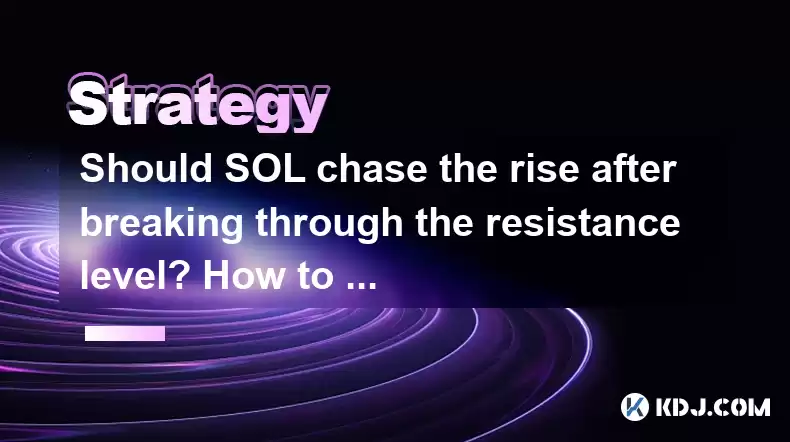-
 bitcoin
bitcoin $112715.707551 USD
-1.71% -
 ethereum
ethereum $4101.475385 USD
-3.01% -
 tether
tether $1.000644 USD
-0.02% -
 bnb
bnb $1207.619465 USD
-6.77% -
 xrp
xrp $2.501451 USD
-3.98% -
 solana
solana $202.947124 USD
-3.32% -
 usd-coin
usd-coin $1.000295 USD
0.04% -
 dogecoin
dogecoin $0.203884 USD
-4.47% -
 tron
tron $0.317154 USD
-1.72% -
 cardano
cardano $0.695009 USD
-4.43% -
 hyperliquid
hyperliquid $38.853961 USD
-8.23% -
 chainlink
chainlink $18.988674 USD
-4.64% -
 ethena-usde
ethena-usde $1.000233 USD
-0.03% -
 stellar
stellar $0.337050 USD
-3.63% -
 bitcoin-cash
bitcoin-cash $536.861728 USD
-1.28%
Should SOL chase the rise after breaking through the resistance level? How to set a stop loss to protect profits?
After SOL breaks resistance, analyze market trends and volume before chasing the rise. Set a stop loss below key support levels to protect profits.
Apr 29, 2025 at 07:21 am

When considering whether to chase the rise of Solana (SOL) after it breaks through a resistance level, investors must carefully analyze the market conditions and their investment strategy. Similarly, setting an effective stop loss to protect profits is crucial for managing risk in the volatile cryptocurrency market. This article will delve into both aspects, providing detailed guidance on making informed decisions and implementing protective measures.
Understanding Resistance Levels and Market Trends
Resistance levels in cryptocurrency trading refer to the price points at which an asset tends to encounter selling pressure, preventing it from rising further. When SOL breaks through such a level, it can signal a potential upward trend. However, the decision to chase the rise should not be taken lightly.
Analyzing market trends and volume is essential. If the breakout is accompanied by high trading volume, it may indicate strong buyer interest and a more sustainable upward movement. Conversely, a breakout with low volume might suggest a false breakout, where the price may soon revert to the resistance level.
Technical indicators such as the Relative Strength Index (RSI) and Moving Averages can also provide insights. If the RSI is not overbought (typically below 70) and the price is above key moving averages, it might be a safer time to enter the market.
Risks of Chasing the Rise
Chasing the rise after a breakout carries inherent risks. One of the primary risks is buying at the peak, just before a potential reversal. This can lead to significant losses if the price fails to sustain its upward momentum.
Another risk is emotional trading. The fear of missing out (FOMO) can drive investors to make impulsive decisions, often leading to buying at inflated prices. It's crucial to maintain a disciplined approach and not let emotions dictate trading decisions.
Strategies for Chasing the Rise
If you decide to chase the rise, consider the following strategies:
Wait for a Retest: After breaking through a resistance level, SOL might retest that level as new support. Waiting for this retest can provide a more favorable entry point with reduced risk.
Use Limit Orders: Instead of chasing the price directly, set a limit order slightly below the current market price. This can help you buy at a better price if the market pulls back slightly.
Monitor Market Sentiment: Pay attention to news and social media sentiment, as these can significantly influence SOL's price movements. Positive developments or endorsements can fuel further rises.
Setting a Stop Loss to Protect Profits
A stop loss is an order placed with a broker to buy or sell once the stock reaches a certain price. It is designed to limit an investor's loss on a security position. For SOL, setting a stop loss can help protect profits and manage risk effectively.
Determining the Stop Loss Level
To set an effective stop loss, consider the following factors:
Volatility: SOL, like many cryptocurrencies, can be highly volatile. Assess the average volatility using tools like the Average True Range (ATR) to set a stop loss that accounts for normal price fluctuations.
Support Levels: Identify key support levels below the current price. Placing a stop loss just below a support level can help avoid being stopped out by minor price dips.
Risk-Reward Ratio: Determine your risk-reward ratio. A common ratio is 1:2, meaning you're willing to risk $1 to make $2. This can guide where to set your stop loss relative to your target profit.
Implementing a Stop Loss
To implement a stop loss for SOL, follow these steps:
Choose a Trading Platform: Ensure your chosen platform supports stop loss orders. Popular platforms like Binance, Coinbase Pro, and Kraken offer this feature.
Log into Your Account: Access your trading account and navigate to the trading interface.
Select SOL: Choose Solana (SOL) as the asset you wish to trade.
Set the Stop Loss Order: In the order section, select 'Stop-Limit' or 'Stop-Market' order type. For a Stop-Limit order:
- Set the 'Stop Price' at the level where you want the order to be triggered.
- Set the 'Limit Price' at the price you're willing to sell at once the stop price is reached.
Review and Confirm: Double-check your stop loss settings and confirm the order.
Monitor and Adjust: Regularly review your stop loss levels and adjust them as necessary based on new market information and price movements.
Trailing Stop Losses
A trailing stop loss can be particularly useful for SOL, as it automatically adjusts the stop price as the market price moves in your favor. This allows you to lock in profits while still giving the asset room to grow.
To set a trailing stop loss:
Choose a Trailing Percentage or Fixed Amount: Decide whether you want the trailing stop to be a percentage of the current price or a fixed amount.
Set the Trailing Stop: On your trading platform, select 'Trailing Stop' and input your chosen percentage or amount.
Monitor and Adjust: Keep an eye on the market and adjust the trailing stop as needed to ensure it remains effective.
Using Technical Analysis for Stop Loss Placement
Technical analysis can help in setting more precise stop loss levels. Key tools include:
Moving Averages: Placing a stop loss just below a significant moving average, like the 50-day or 200-day, can provide a logical exit point.
Fibonacci Retracement Levels: These can help identify potential support levels where a stop loss might be placed.
Candlestick Patterns: Recognizing bearish reversal patterns can signal when to tighten a stop loss to protect profits.
Frequently Asked Questions
Q: Can I set multiple stop losses for different portions of my SOL holdings?A: Yes, you can set multiple stop losses for different portions of your SOL holdings. This strategy, known as scaling out, allows you to lock in profits at different price levels. For example, you might set a stop loss for 30% of your holdings at a lower level and another for the remaining 70% at a higher level, allowing you to manage risk and potential profits more flexibly.
Q: How often should I adjust my stop loss for SOL?A: The frequency of adjusting your stop loss for SOL depends on market volatility and your trading strategy. In highly volatile markets, you might need to adjust it more frequently, perhaps daily or weekly. In more stable conditions, monthly adjustments might suffice. Always consider new market data and price movements when deciding whether to adjust your stop loss.
Q: Is it better to use a percentage-based or fixed amount stop loss for SOL?A: The choice between a percentage-based and a fixed amount stop loss for SOL depends on your risk tolerance and investment goals. A percentage-based stop loss adjusts with the price, which can be beneficial in volatile markets. A fixed amount stop loss provides a consistent dollar amount of risk, which might be preferred if you want to limit your exposure to a specific amount. Consider your overall portfolio and risk management strategy when choosing.
Q: Can I use a stop loss to enter a position in SOL?A: Yes, you can use a stop loss to enter a position in SOL, known as a 'buy stop order'. This type of order is placed above the current market price and is triggered when the price reaches or exceeds the specified level. This strategy can be useful if you believe SOL will continue to rise after breaking through a resistance level, allowing you to enter the market at a potentially advantageous point.
Disclaimer:info@kdj.com
The information provided is not trading advice. kdj.com does not assume any responsibility for any investments made based on the information provided in this article. Cryptocurrencies are highly volatile and it is highly recommended that you invest with caution after thorough research!
If you believe that the content used on this website infringes your copyright, please contact us immediately (info@kdj.com) and we will delete it promptly.
- Tokenization Takes Center Stage: SEC-Registered Stock Tokens Reshape Finance
- 2025-10-15 22:25:13
- Bitcoin Seized, Transferred: A New York Minute on Crypto's Wild Ride
- 2025-10-15 22:25:13
- Milk & Mocha's $HUGS: Can This Crypto Presale Deliver a 100x Portfolio?
- 2025-10-15 22:30:01
- Memecoins Grow Up: $HUGS Presale Offers Real Utility
- 2025-10-15 22:45:13
- HUGS Launch, Crypto Bull Run, and a Perfect Storm Brewing?
- 2025-10-15 22:45:13
- Zero Knowledge Proof, Whitelists, and the Future of Blockchain Privacy
- 2025-10-15 22:30:01
Related knowledge

Practical parameter settings for a Bitcoin multi-timeframe moving average system
Sep 18,2025 at 10:54pm
Optimizing Timeframe Combinations for Bitcoin Trading1. Selecting appropriate timeframes is crucial when building a multi-timeframe moving average sys...

How can I filter out false breakouts in Dogecoin high-frequency trading?
Sep 22,2025 at 01:00am
Understanding False Breakouts in Dogecoin Trading1. A false breakout occurs when Dogecoin's price appears to move beyond a defined support or resistan...

Techniques for identifying tops and bottoms in the Bitcoin on-chain NVT model
Sep 20,2025 at 07:54pm
Understanding the NVT Model in Bitcoin Analysis1. The Network Value to Transactions (NVT) ratio is often described as the 'P/E ratio' of the cryptocur...

What does the surge in open interest in Bitcoincoin futures mean?
Sep 20,2025 at 11:18pm
Understanding the Surge in Dogecoin Futures Open Interest1. A surge in open interest within Dogecoin futures indicates a growing number of active cont...

How can I use the Ethereum USDT premium to gauge market sentiment?
Sep 18,2025 at 11:55pm
Understanding the Ethereum USDT Premium1. The Ethereum USDT premium refers to the price difference between USDT (Tether) traded on Ethereum-based plat...

What should I do if Ethereum staking yields decline?
Sep 20,2025 at 06:18am
Understanding the Causes Behind Declining Ethereum Staking Yields1. The Ethereum network transitioned to a proof-of-stake consensus mechanism with the...

Practical parameter settings for a Bitcoin multi-timeframe moving average system
Sep 18,2025 at 10:54pm
Optimizing Timeframe Combinations for Bitcoin Trading1. Selecting appropriate timeframes is crucial when building a multi-timeframe moving average sys...

How can I filter out false breakouts in Dogecoin high-frequency trading?
Sep 22,2025 at 01:00am
Understanding False Breakouts in Dogecoin Trading1. A false breakout occurs when Dogecoin's price appears to move beyond a defined support or resistan...

Techniques for identifying tops and bottoms in the Bitcoin on-chain NVT model
Sep 20,2025 at 07:54pm
Understanding the NVT Model in Bitcoin Analysis1. The Network Value to Transactions (NVT) ratio is often described as the 'P/E ratio' of the cryptocur...

What does the surge in open interest in Bitcoincoin futures mean?
Sep 20,2025 at 11:18pm
Understanding the Surge in Dogecoin Futures Open Interest1. A surge in open interest within Dogecoin futures indicates a growing number of active cont...

How can I use the Ethereum USDT premium to gauge market sentiment?
Sep 18,2025 at 11:55pm
Understanding the Ethereum USDT Premium1. The Ethereum USDT premium refers to the price difference between USDT (Tether) traded on Ethereum-based plat...

What should I do if Ethereum staking yields decline?
Sep 20,2025 at 06:18am
Understanding the Causes Behind Declining Ethereum Staking Yields1. The Ethereum network transitioned to a proof-of-stake consensus mechanism with the...
See all articles










































































